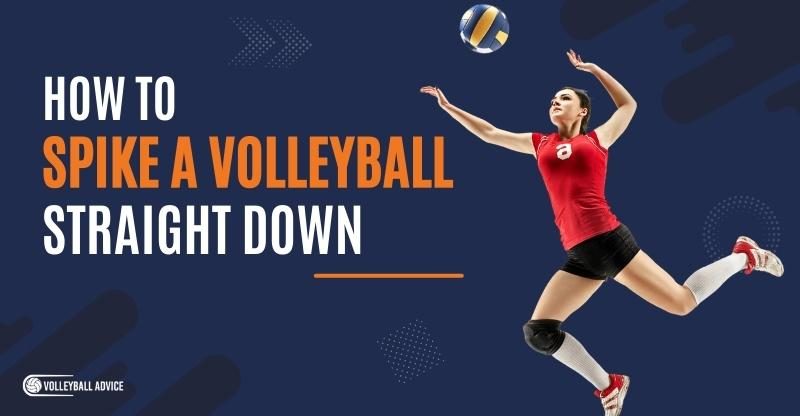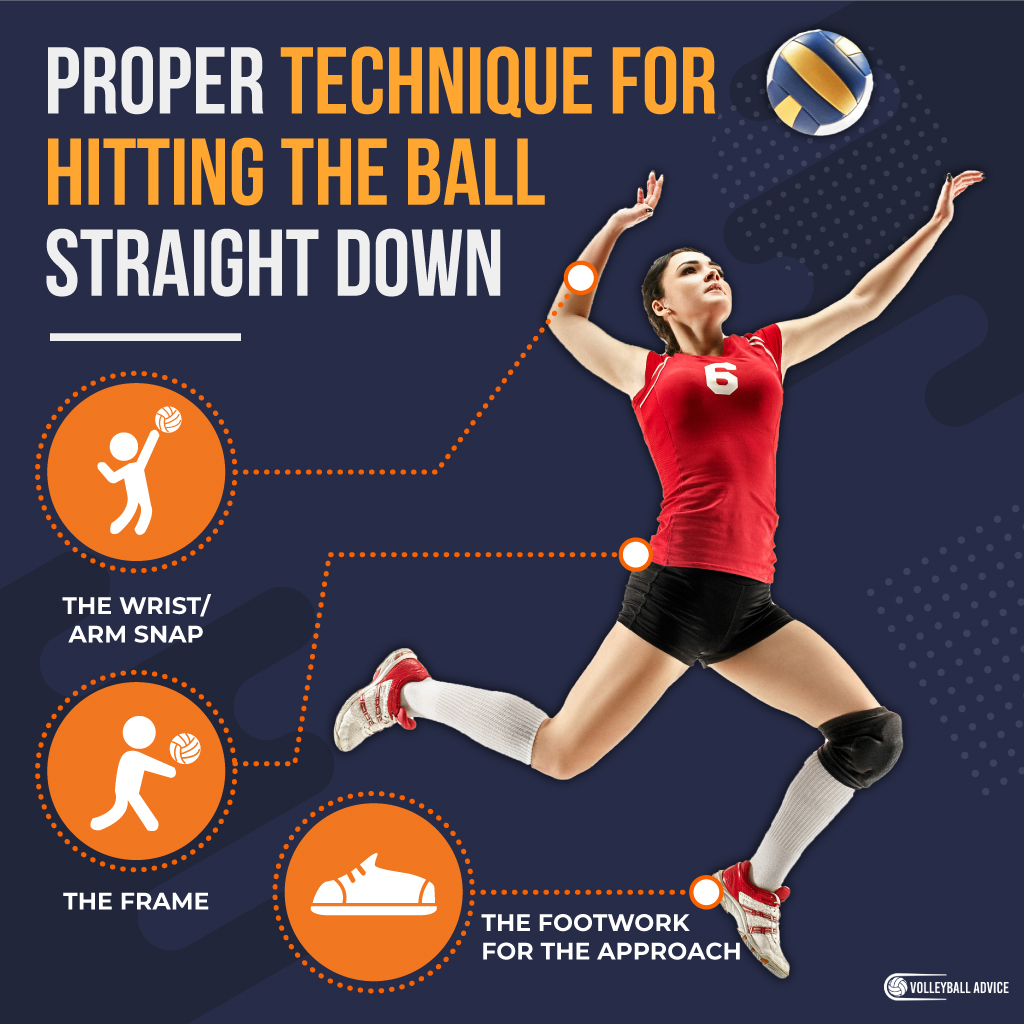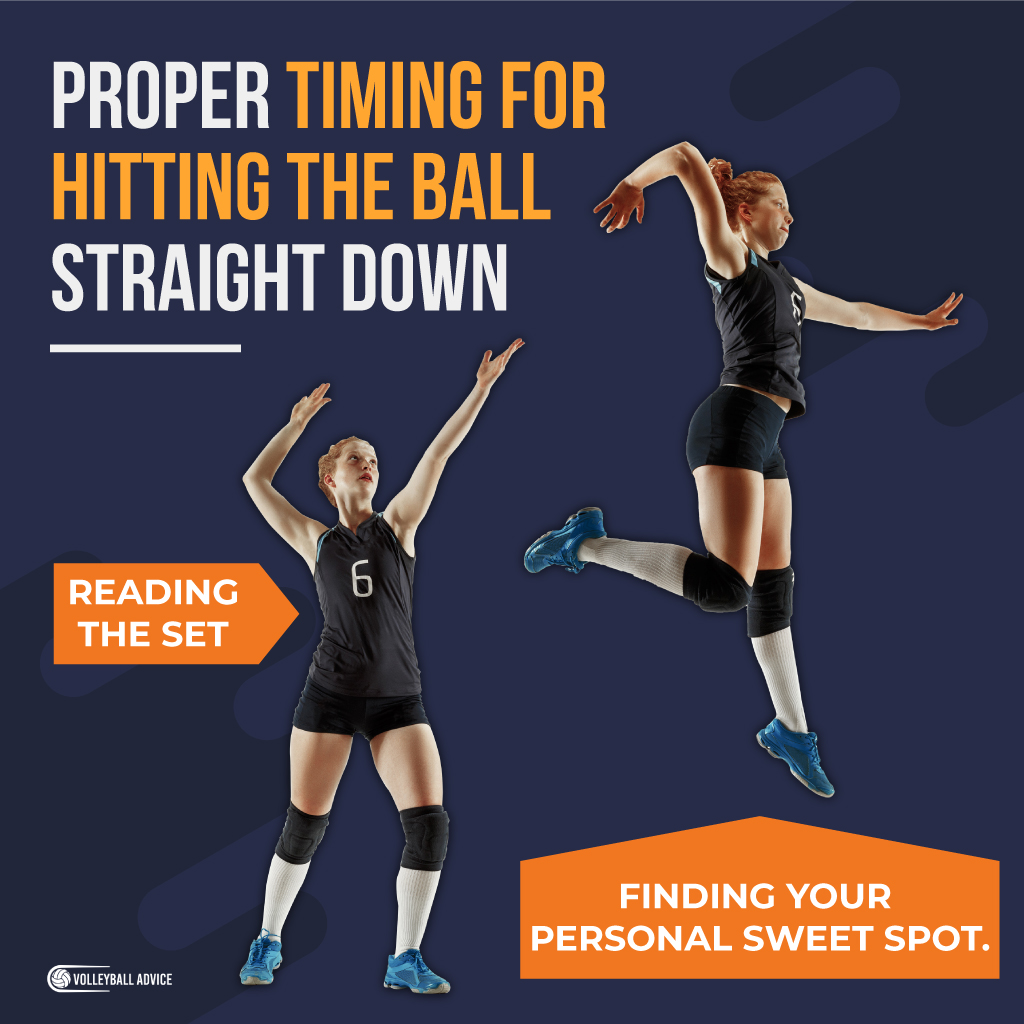How To Spike A Volleyball Straight Down (A Coach Explains)
Hitting is the most exciting part about volleyball, and in a world of montages and highlight reels, there’s nothing more satisfying than slamming the ball straight down.
So, how do you spike a volleyball straight down? To spike a volleyball straight down, you need to have proper hitting technique (a strong frame, clean arm “snap”, and proper footwork), have good timing (allowing you to hit the “sweet spot”), and hit the ball from above. Remember: at the end of the day, angles are more important than height.
While many players make spiking a volleyball straight down look effortless, it can prove challenging to find your sweet spot and hitting zone along the way to that perfect bounce.
These can be learned through time, repetition, and practice, but you won’t get anywhere if you don’t know what you’re looking for.
Intentional practice is key, and if you’re still feeling lost after hours of research and YouTube videos, you’ve come to the right place. Let’s take a look.
Proper Technique For Hitting The Ball Straight Down (3 Criteria)
There are three main criteria when it comes to your technique in order to hit the ball straight down:
- The frame
- The wrist/arm snap
- The footwork for the approach
These three things combined will make the biggest differences in changing your hit to bounce on the ten foot line and not the back wall.
However, before explaining each of these technical components, the most important factor is how disciplined you are in practicing your technique.
Discipline – especially the ability to listen – is the first thing most coaches drill into their players.
Being disciplined on the court builds the muscle memory needed to perform under pressure, and the clean, efficient movements to execute your role as a player to the best of your ability.
1. Framing the Hit
A proper hitting frame involves the dominant/hitting arm cocked at an angle with the palm facing outwards (the “shooter’s pose”, as if you’re about to shoot a bow and arrow) and the opposite arm pointing towards the point of contact.
Your body should be slightly angled towards your dominant arm, with your shoulders back and chest lifted upwards. But as anyone who’s tried hitting a volleyball knows, this doesn’t necessarily make the ball go down.
So how does it happen? The key is in the wrist/arm snap.
2. Wrist/Arm Snap
When your shoulders begin to rotate, swiveling your arm and extending the elbow, make sure that your wrist “snaps” when it contacts the ball – finishing with the palm facing towards the ground.
The same is true of the elbow: make sure it “snaps” and extends, creating leverage. This will let you hit at a sharp angle and send the ball towards the floor.
Experiment with finishing with your palm facing different directions – this will be good practice for aiming while hitting, another essential skill.
Practice makes perfect, and you need to practice proper hitting technique without an approach (stay on the ground). Hit the ball below the net or against a wall until you feel confident that you can control its angle.
When you can regularly spike the ball straight down from a standing position, it’s time to move onto jumping.
3. The Footwork For The Approach
Many problems volleyball players face have to do with balance, and one of the biggest issues is when players have their weight backwards. This usually has to do with fear.
Breaking the mental fear of getting hit is the biggest obstacle involved in fixing this, but once it’s conquered you’ll evolve as a player. Volleyball is a game of moving forward, never backwards, and this should be your guiding mantra as a player.
For hitting, strive to be jumping forward through the ball. This will generate more power, but also give you the stability to hit the ball directly down.
Imagine if the ball was set slightly behind you, making you jump backwards to hit it: it’s hard enough to contact it, let alone have the momentum to generate any power.
On top of this, you have lost almost every angle to hit at except deep back court, and hitting the ball straight down is virtually impossible. Try with a less extreme example, and you’ll find the same is still true.
Practice with your setter, having them set the ball just off the net, with plenty of room to hit. Approach with confidence and jump behind the ball, moving forwards as you hit, and you will find that it’s much easier to hit down.
Don’t get discouraged if it goes in the net – it’s going to take time to find that sweet spot. The most important thing is to keep moving forward.
Proper Timing For Hitting The Ball Straight Down
No matter how good your technique is, no matter how amazing your vertical, without good timing you’ll never be able to hit straight down.
This skill is best learned over time with experience, but there are two main facets to consider improving:
- Reading the set
- Finding your personal sweet spot.
Reading the Set
Every setter has their own style and point of contact, based on their height, vertical, arm length, experience, and personal style of playing. Be patient with your setter and give them time to adjust to you as a hitter.
Reading the set involves watching the ball from the time it is released from the setter’s hands to the moment you begin your approach. Especially when playing beach volleyball, factors like wind, sun, and ball pressure can affect how it moves, and you should be prepared to move and adjust to it.
Unless you’re hitting middle quicks – in which case this section doesn’t apply to you – you will have time to watch the ball before you start your approach.
Watch for it to hit its peak, and use that to set up your approach. You should aim to contact the ball at the highest point of your jump, giving yourself the most options and the ability to hit down if you choose.
You may struggle to align the timing of your footwork with the perfect point of contact for the ball, but there’s no solution except to practice. Pay attention to the ball, talk to your setter, and be patient.
Reading the set is an important skill for any hitter, but especially so for those wanting to hit the ball straight down. Without it, you’ll never be in the right place at the right time, and that highlight play won’t ever make the final cut.
The Sweet Spot
So you’ve perfected your frame, you’ve mastered your approach, and you have the timing down to a tee (or so you think). But you still can’t hit the ball straight down. Luckily, you’re not alone.
It’s possible that you aren’t hitting from your sweet spot. Even if slightly off, this makes your life exponentially harder as a hitter and will make it much harder to hit straight down.
The sweet spot (or “hitter’s box”) is a term used to describe a hitter’s perfect point of contact. This is the area where your arm’s maximum extension meets the forward momentum generated by your approach to create an imaginary box roughly measuring one cubic foot slightly in front and above you.
To find your sweet spot, use a wall or pillar, or any surface that is taller than your standing arm reach. Assume a proper hitting frame and flow through your hit slowly, contacting the wall at about forty-five degrees from your standing arm reach. Adjust a hand’s breadth higher (or more if comfortable), and practice hitting the ball from this spot.
Everyone’s sweet spot is different, but finding it is important to becoming an excellent hitter. With a stable frame mid-air, hitting from here will give you the best chance of spiking the ball straight down.
Check out this guide: Hand Position for Spiking in Volleyball (Tips and Tricks)
Does Being Short Negatively Impact Your Hitting Abilities?
Volleyball is known for several stereotypes, but height is one of them.
Whether player or jump height, volleyball is a sport where the action takes place in the air, and the higher you fly the farther you’ll climb. It’s a battle against gravity, and the side that lets the ball touch the ground first loses.
Hitting the ball straight down requires both an understanding of how to leverage height and the angles involved in bouncing the ball straight down. These are the last pieces of the puzzle we’ve been working on, so let’s dive in.
Are You Too Short? (Hint: No)
By far the biggest assumption about volleyball is that you have to be tall to play.
This is totally untrue, and some of the most talented players I know are under six foot (@issabatrane).
View this post on Instagram
When it comes to spiking the ball straight down, though, it’s a bit more complicated.
The fact is, taller players will always have the advantage of reaching the angles needed to hit straight down due to longer limbs and by nature of being tall. It’s easier to hit straight down when you easily jump above the net, but you can still manage if you’re shorter.
The key is jump height.
There’s no shortcut or cheat code for this: if you want to compete against taller players and still hit straight down, you need to be able to reach where they do.
Train your legs and practice dynamic exercises like Hang Cleans, Jump Squats, and Box Jumps, and work with your setter to give you the angles you need to dominate. After all, when it comes to hitting straight down, angles are everything.
Angles Are More Important Than Height
Angles determine the spike in volleyball. But what does that mean?
Think of it this way. If you were holding a ball and wanted to spike it down from a relaxed, standing position, you would simply hit the top of the ball. If you hit below, it would go upwards, and hitting it flat would make it shoot forwards. To spike down, we need to hit the top of the ball. https://shop.viavisolutions.com/
So if it’s that easy, why doesn’t everyone spike straight down?
The problem lies with the net.
In order to hit the ten foot line (or closer) with a spike, you need several things: to be above the net, to contact the top of the ball, and to have enough space for the ball to find that angle.
A vector must exist connecting the point of contact (where you hit the ball) and the point of impact (where it lands). If the net interrupts this line at any point, the spike will fail.
If we draw a line from the point of impact to the closest point of contact, you’ll see that it exists directly above the net.
This is the lowest point that the ball can be set in order to be spiked straight down, but it doesn’t allow for the hitter to avoid the block at all.
Continuing the line upwards, the ball now has space away from the net, but is much higher for the hitter to connect with. Following this graph several steps further, we find that the ball is much too high for even professional players to contact.
The math checks out, and we’ve all seen players bounce the ball at an insane angle straight down and hoped to do it ourselves. It is definitely possible, but you need to be reasonable with your expectations as a player.
Contacting the ball from above is a must. If you have the vertical jump height to connect with the ball away from the net and get above it – that’s great. Keep jumping for the stars.
For the rest of us, ask your setter to set almost directly on top of the net to practice that first spike straight down, and add height and distance from the net as you practice.
If it seems impossible to hit down when it’s off the net, that’s totally fine. Volleyball isn’t about spiking the ball straight down, it’s about putting it where it needs to go. Sometimes that’s straight down, but most of the time it’s not.
Experiment with the angles you can hit at and find a compromise that works for you. Maybe you will have to increase your vertical jump height before you can hit straight down, but don’t let it frustrate you. Be kind to yourself as a player, and you’ll wind up exactly where you need to be.
Other Spiking Resources
- How To Spike A Volleyball If You’re Short
- 16 Types Of Spiking In Volleyball
- How To Practice Spiking A Volleyball With No Net (10 Drills)
Strength & Conditioning Article
About The Author
Ailan Samuel is a writer and athlete who has played volleyball at the university, club, and national level since 2012. He has competed successfully in both beach and indoor competitions, resulting in four silver and two gold medals, and was awarded the Half-Blue while playing in Scotland. He received his MA in English and Medieval History from the University of St Andrews, Scotland, and is currently studying for his MA in Publishing and Creative Writing at Bournemouth University.



